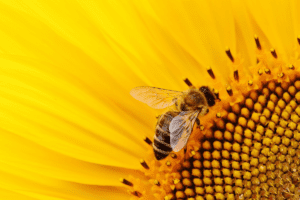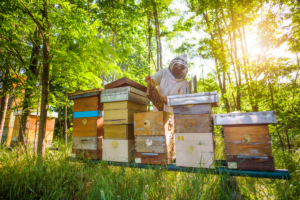Bees play a crucial role in maintaining the health and stability of ecosystems around the world. As primary pollinators, they facilitate the reproduction of many flowering plants, which in turn produce the fruits, seeds, and nuts that make up a significant portion of the human diet. Approximately 75% of global food crops depend, at least in part, on pollination by bees and other insects. This includes vital crops like apples, almonds, blueberries, and cucumbers. Without bees, the yield and quality of these crops would significantly decline, leading to reduced food availability and increased prices.
Moreover, bees contribute to the biodiversity of ecosystems by supporting the growth of a variety of plants, which provide habitat and food for other wildlife. The pollination services provided by bees are estimated to be worth billions of dollars annually to agriculture and horticulture industries. Thus, the health of bee populations is directly linked to global food security and economic stability.
Understanding Colony Collapse Disorder
Colony Collapse Disorder (CCD) is a phenomenon where the majority of worker bees in a colony disappear, leaving behind a queen, ample food, and a few nurse bees to care for the remaining immature bees and the queen. This mysterious and distressing occurrence was first widely reported in the early 2000s and has since become a major concern for beekeepers, scientists, and environmentalists alike.
Several factors have been identified as potential contributors to CCD, including parasitic mites (like the Varroa destructor), various pathogens (such as viruses, bacteria, and fungi), pesticide exposure, environmental stressors, and nutritional deficiencies. The interaction between these factors creates a complex web of challenges that weaken bee colonies and make them more susceptible to collapse.
The decline of bee populations due to CCD and other factors is alarming, given their critical ecological and economic roles. Addressing this issue requires a multifaceted approach that includes sustainable agricultural practices, habitat conservation, scientific research, and public awareness. In the following sections, we will explore the main causes of colony collapse and discuss strategies to prevent it, ensuring the survival of these indispensable pollinators.
Main Causes of Colony Collapse
Parasitism and Diseases
One of the primary causes of colony collapse is the prevalence of parasites and diseases. The Varroa destructor mite is particularly devastating, as it attaches to bees and feeds on their bodily fluids, weakening them and transmitting harmful viruses. Other pathogens, including Nosema (a fungal infection) and various bacterial and viral infections, further exacerbate the health issues facing bee colonies. The cumulative impact of these parasites and diseases can decimate colonies, making effective management and treatment critical.
Pesticide Use
Pesticides, especially neonicotinoids, have been linked to negative effects on bee health. These chemicals can disrupt bees’ navigation abilities, reduce foraging efficiency, and impair reproduction. Sublethal exposure to pesticides can weaken bees’ immune systems, making them more susceptible to diseases and parasites. The widespread use of pesticides in agriculture poses a significant risk to bee populations, necessitating the development of safer alternatives and stricter regulations.
Habitat Loss and Monoculture
The loss of natural habitats due to urbanization, deforestation, and intensive agriculture reduces the availability of diverse forage for bees. Monoculture farming, where single crops are grown over large areas, exacerbates this issue by limiting the variety of nectar and pollen sources. This lack of diversity in diet can lead to nutritional deficiencies in bees, weakening their immune systems and reducing colony resilience.
Climate Change
Climate change affects bees in multiple ways. Rising temperatures can alter the timing of flowering plants, disrupting the synchrony between bee activity and the availability of forage. Extreme weather events, such as prolonged droughts and heavy rainfall, can destroy habitats and food sources. Additionally, climate change can exacerbate the spread of diseases and parasites, further threatening bee populations. Mitigating the impacts of climate change is essential to preserving healthy bee colonies.
Sustainable Management Strategies
Bee-Friendly Agricultural Practices
Implementing agricultural practices that are friendly to bees is crucial for their survival. This includes planting cover crops and flowering plants alongside main crops to provide continuous forage. Reducing tillage and adopting organic farming methods can also enhance soil health and support a thriving bee population. Crop rotation and diversification can help create a more bee-friendly landscape, promoting their well-being.
Reducing Pesticide Use
Minimizing the use of harmful pesticides is essential to protecting bee populations. Farmers can adopt integrated pest management (IPM) practices, which involve using biological controls and other non-chemical methods to manage pests. When pesticide use is necessary, selecting bee-safe products and applying them during times when bees are not active can reduce the risk of exposure. Education and training for farmers on the impacts of pesticides on bees can also drive more sustainable practices.
Integrated Pest Management (IPM)
IPM is a holistic approach to pest control that emphasizes the use of multiple strategies to manage pest populations with minimal harm to the environment. This approach includes monitoring pest levels, using biological controls such as beneficial insects, and applying chemical treatments only when necessary. IPM can help reduce the reliance on harmful pesticides, thereby protecting bee health while maintaining effective pest control.
Promoting Biodiversity
Encouraging biodiversity in agricultural and natural landscapes can provide bees with diverse and abundant forage. Planting wildflowers, maintaining hedgerows, and preserving natural habitats can create a rich and varied environment for bees. Biodiversity not only supports bee populations but also enhances the resilience and productivity of ecosystems as a whole.
Government Initiatives and Public Policies
Apiculture Incentive Programs
Government programs that support beekeeping can play a vital role in sustaining bee populations. These programs can provide financial assistance, training, and resources to beekeepers, helping them manage their colonies more effectively. Incentives for planting bee-friendly crops and conserving habitats can also encourage practices that benefit bees.
Pesticide Regulation
Stricter regulations on pesticide use are necessary to protect bee health. Governments can implement policies that restrict the use of harmful pesticides, promote safer alternatives, and require comprehensive testing of new chemicals for their impact on bees. Transparent labeling and public awareness campaigns can also inform consumers and farmers about the risks associated with certain pesticides.
Habitat Preservation
Preserving and restoring natural habitats is essential for supporting healthy bee populations. Governments can establish protected areas, promote sustainable land use practices, and provide incentives for habitat conservation on private lands. Policies that encourage urban planning and development to incorporate green spaces and pollinator-friendly environments can also contribute to habitat preservation.
Innovation and Technology in Beekeeping
Colony Monitoring with IoT Technology
Advancements in technology are providing new tools for beekeepers to monitor and manage their colonies. Internet of Things (IoT) devices, such as sensors and smart hives, can track hive conditions in real-time, alerting beekeepers to potential issues such as disease outbreaks, temperature fluctuations, and food shortages. This data-driven approach enables more proactive and precise management, improving colony health and productivity.
Development of Natural Pesticides
Research into natural pesticides and biocontrol agents is offering promising alternatives to synthetic chemicals. These products, derived from natural sources such as plants and microorganisms, can effectively manage pests with minimal impact on bees and other beneficial insects. Continued innovation and investment in developing and commercializing natural pesticides can help reduce the reliance on harmful chemicals in agriculture.
Breeding Disease-Resistant Bees
Selective breeding programs aim to develop bee strains that are more resistant to diseases and parasites. By identifying and propagating bees with desirable traits, such as hygienic behavior and genetic resistance to mites and pathogens, researchers and beekeepers can create stronger, more resilient colonies. Collaboration between breeding programs and beekeepers is essential to ensure the widespread adoption of these improved bee strains.
Education and Awareness
Public Awareness Campaigns
Raising public awareness about the importance of bees and the threats they face is crucial for mobilizing action. Campaigns that highlight the role of bees in pollination, food production, and ecosystem health can inspire individuals and communities to take steps to protect bees. Initiatives such as “Bee Friendly” certifications for products and businesses can also promote consumer choices that support bee conservation.
Environmental Education in Schools
Incorporating environmental education into school curricula can foster a generation of environmentally conscious citizens. Teaching students about the significance of bees, the challenges they face, and ways to support pollinator health can instill a sense of stewardship and responsibility. School gardens and beekeeping programs can provide hands-on learning experiences that reinforce these concepts.
Community Involvement in Bee Preservation
Engaging local communities in bee conservation efforts can have a significant impact. Community gardens, urban beekeeping projects, and volunteer initiatives to plant pollinator-friendly habitats can all contribute to creating supportive environments for bees. Building partnerships between local governments, organizations, and residents can amplify these efforts and foster a collective commitment to bee preservation.
The Role of Non-Governmental Organizations (NGOs)
Bee Conservation Projects
NGOs play a vital role in advancing bee conservation through research, advocacy, and on-the-ground projects. These organizations often spearhead initiatives to protect and restore habitats, promote sustainable practices, and support beekeepers. Collaborative efforts between NGOs, governments, and private sector stakeholders can enhance the effectiveness and reach of conservation programs.
Partnerships between NGOs and Local Communities
Successful bee conservation often relies on strong partnerships between NGOs and local communities. By working together, they can identify and address specific challenges facing bee populations in their regions. Community-driven projects, supported by NGO expertise and resources, can create sustainable and locally appropriate solutions for bee preservation.
The Urgency of Collective Action
Addressing the crisis of colony collapse and ensuring the survival of bees requires urgent and coordinated action from all sectors of society. Governments, scientists, farmers, businesses, and individuals must work together to implement the strategies outlined in this article. By prioritizing bee health and promoting sustainable practices, we can protect these vital pollinators and the ecosystems they support.
A Sustainable Future for Bees and Humanity
The future of bees is intrinsically linked to our own. Ensuring their survival is not only an ecological imperative but also a necessity for food security and economic stability. Through concerted efforts and a commitment to sustainability, we can create a future where bees thrive, ecosystems flourish, and humanity benefits from the essential services that bees provide.

Hi, I’m James Stevan, an avid beekeeper with over a decade of experience in apiculture. My passion for bees drives me to share practical tips and insights on sustainable beekeeping. Join me as we explore the fascinating world of bees and their crucial role in our ecosystem.




